Platelet density distribution in essential thrombocythemia.
Pathophysiology of Haemostasis and Thrombosis
Pub Date : 2010-01-01
Epub Date: 2010-05-19
DOI:10.1159/000314964
引用次数: 15
Abstract
Essential thrombocythemia (ET) is characterized by high platelet counts and a slightly increased bleeding risk. Why severe hemorrhage does not occur more frequently is not known. Variations of platelet density (kg/l) depend mainly on cell organelle content in that high-density platelets contain more α and dense granules. This study compares ET patients (n = 2) and healthy volunteers (n = 2) with respect to platelet density subpopulations. A linear Percoll™ gradient containing prostaglandin E1 was employed to separate platelets according to density. The platelet population was subsequently divided by density into 16 or 17 subpopulations. Determination of platelet counts was carried out. In each density fraction, platelet in vivo activity, i.e. platelet-bound fibrinogen, was measured using a flow cytometer. To further characterize platelet subpopulations, we determined intracellular concentrations of CD40 ligand (CD40L) and P-selectin in all fractions. Patients and controls demonstrated similar density distributions, i.e. 1 density peak. High-density platelets had more surface-bound fibrinogen in conjunction with signs of platelet release reactions, i.e. with few exceptions they contained less CD40L and P-selectin. Peak density platelets showed less surface-bound fibrinogen. These platelets contained less CD40L and P-selectin than nearby denser populations. The light platelets had more surface-bound fibrinogen than peak platelets together with elevated concentrations of CD40L. In ET, the malignant platelet production could exist together with platelets originating from normal megakaryocytes. It is also possible that clonal megakaryocytes produce platelets covering the entire density span. The ‘normal’ density distribution offers a tenable explanation as to why serious bleedings do not occur more frequently.原发性血小板增多症的血小板密度分布。
原发性血小板增多症(ET)的特点是血小板计数高,出血风险略有增加。为什么严重出血没有更频繁地发生尚不清楚。血小板密度(kg/l)的变化主要取决于细胞器含量,高密度血小板含有更多的α和致密颗粒。本研究比较了ET患者(n = 2)和健康志愿者(n = 2)在血小板密度亚群方面的差异。采用含有前列腺素E(1)的线性Percoll™梯度根据密度分离血小板。血小板种群随后按密度划分为16或17个亚种群。测定血小板计数。在每个密度分数中,血小板体内活性,即血小板结合纤维蛋白原,使用流式细胞仪测量。为了进一步表征血小板亚群,我们测定了所有组分中CD40配体(CD40L)和p -选择素的细胞内浓度。患者和对照组表现出相似的密度分布,即1个密度峰。高密度血小板有更多的表面结合纤维蛋白原,并伴有血小板释放反应的迹象,即除了少数例外,它们含有较少的CD40L和p -选择素。峰值密度血小板表面结合纤维蛋白原较少。这些血小板含有较少的CD40L和p -选择素比附近密集的人群。轻血小板表面结合纤维蛋白原比峰值血小板多,CD40L浓度升高。在ET中,恶性血小板生成可与正常巨核细胞产生的血小板同时存在。克隆巨核细胞也可能产生覆盖整个密度跨度的血小板。“正态”密度分布提供了一个站得住脚的解释,为什么严重出血不会更频繁地发生。
本文章由计算机程序翻译,如有差异,请以英文原文为准。
求助全文
约1分钟内获得全文
求助全文

 求助内容:
求助内容: 应助结果提醒方式:
应助结果提醒方式:


